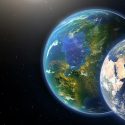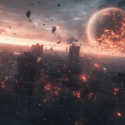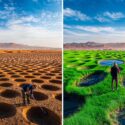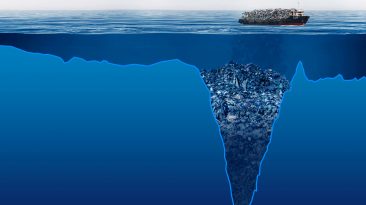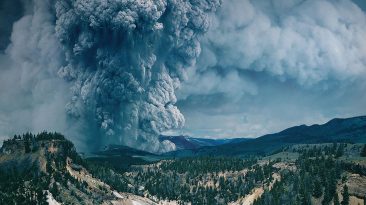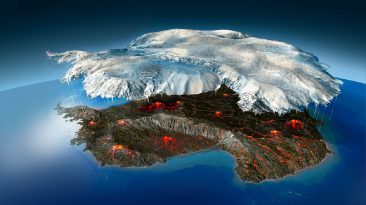About 65 million years ago, a mass extinction event occurred, wiping out more than 75% of all species on Earth. There have only been 5 mass extinctions in our planet’s 4.5 billion year history.
But the next one has already started. By the end of this century, one in six species on Earth could be gone.
Will humans go with them? How could we survive a sixth mass extinction? How could we prevent one?
The reason we’re all still alive on this planet is thanks to biodiversity. From the tallest trees, to the biggest animals, to the weirdest plants, to the grossest fungi, to the buzziest bugs, and even the creatures you can’t see, we all rely on each other to make life on Earth possible!
And our world would be harmonious except that…humans are unreliable. Thanks to our unsustainable practices, the world’s wildlife is inching towards an extinction rate that’s 10,000 times faster than what is considered to be natural.
Without taking drastic action, we might soon be facing extinction ourselves. But how far are we willing to go?
Pulitzer Prize-winning author and biologist E.O. Wilson came up with what is now known as the “Half-Earth idea.” It involves making half the planet a “”human-free”” zone, leaving nature to do what it can to stabilize itself.
This means that the current global population of roughly 7.7 billion people would have to make do with half the space it currently has. And for a lot of people, that’s just not feasible.
Cordoning off half the world for extreme conservation would displace roughly one billion people – most of them from low income backgrounds. Think of those parts of the world where overpopulation is severe, and then imagine that situation everywhere!
But housing isn’t our only concern. We also need food and fresh water to survive! Today, one-third of Earth’s land surface and 75 percent of its freshwater resources are used for crop and livestock production.
Yet at least 10% of Earth’s population doesn’t have enough food. How many more people will go hungry when we no longer have access to those resources? Economically speaking, the forestry and fuel industries could collapse because there’d be less land to work with.
This would leave millions of people out of work. But the losses might be recouped in the form of new opportunities in more sustainable fields.
In fact, setting aside half the planet for environmental protection wouldn’t be a total financial disaster. $577 billion (US) in annual global crops are currently at risk due to pollinator loss, while roughly 40 percent of the world’s economy as a whole relies on biological resources.
If we continue down the path we’re on, we risk depleting the bee population in its entirety, as well as the other biological resources we depend on. But by protecting them, their declining numbers may have the opportunity to regenerate, so that we can continue to benefit from their output in a sustainable way.
Of course, it’s not just about the money. The fact is that the more biodiverse an ecosystem is, the healthier it is. A healthy ecosystem can clean water, help to purify the air we breathe, regulate the climate, maintain the soil needed for crops and food, plus recycle nutrients while it’s at it.
In short, we can’t afford to continuing living in a way that accelerates the extinction of other species. Because we need them as much as they need us.
The Half-Earth idea, might be too much. In fact, it’s virtually impossible to implement. But the consequences of doing the bare minimum would be even worse.
We’ve got to spread the word, and remind each other that we’re all in this together – no matter how big, no matter how small. Because every time a species goes extinct, it brings humans closer to their own extinction. Don’t believe me?
Subscribe to What-If on YouTube or follow the show on Facebook Watch.
Sources
- “Saving Half the Planet for Nature Isn’t As Crazy As It Seems”, SIMON WORRALL, 2016. nationalgeographic.com. Accessed on January 27.
- “Can the World Really Set Aside Half of the Planet for Wildlife?”. Tony Hiss, 2014. smithsonianmag.com. Accessed on January 27.
- “5 reasons why biodiversity is a big deal”. RUSSELL MCLENDON, 2019. mnn.com. Accessed on January 27.
- “MEDIA RELEASE: NATURE’S DANGEROUS DECLINE ‘UNPRECEDENTED’; SPECIES EXTINCTION RATES ‘ACCELERATING’”. ipbes.net. Accessed on January 27.
- “Discover Half-Earth”. half-earthproject.org. Accessed on January 27.
- “The Theory of Island Biogeography“. Robert H. MacArthur and Edward O. Wilson. Princeton. Accessed on January 27.
- “Protecting half of the planet could directly affect over one billion people”. Judith Schleicher, Julie G. Zaehringer, Constance Fastré, Bhaskar Vira, Piero Visconti & Chris Sandbrook. Accessed on January 27.
- “What if we gave half the planet entirely back to nature?”. KRISTIN TOUSSAINT. fastcompany.com. Accessed on January 27.



